engine VOLVO S90 1998 Owners Manual
[x] Cancel search | Manufacturer: VOLVO, Model Year: 1998, Model line: S90, Model: VOLVO S90 1998Pages: 175, PDF Size: 4.45 MB
Page 1 of 175
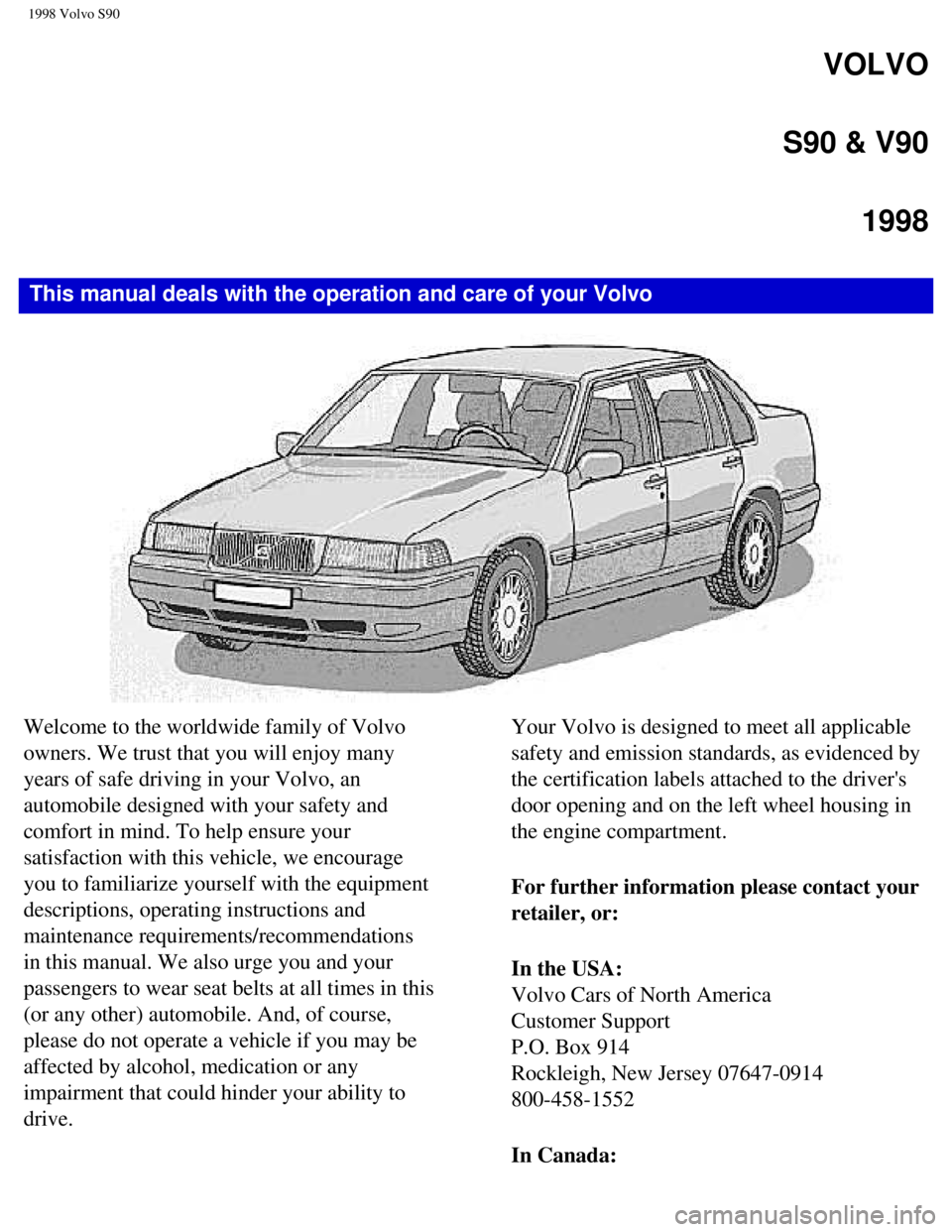
1998 Volvo S90
VOLVO
S90 & V90
1998
This manual deals with the operation and care of your Volvo
Welcome to the worldwide family of Volvo
owners. We trust that you will enjoy many
years of safe driving in your Volvo, an
automobile designed with your safety and
comfort in mind. To help ensure your
satisfaction with this vehicle, we encourage
you to familiarize yourself with the equipment
descriptions, operating instructions and
maintenance requirements/recommendations
in this manual. We also urge you and your
passengers to wear seat belts at all times in this
(or any other) automobile. And, of course,
please do not operate a vehicle if you may be
affected by alcohol, medication or any
impairment that could hinder your ability to
drive. Your Volvo is designed to meet all applicable
safety and emission standards, as evidenced by
the certification labels attached to the driver's
door opening and on the left wheel housing in
the engine compartment.
For further information please contact your
retailer, or:
In the USA:
Volvo Cars of North America
Customer Support
P.O. Box 914
Rockleigh, New Jersey 07647-0914
800-458-1552
In Canada:
file:///K|/ownersdocs/1998/1998_SV90/98S90_000.htm (1 of 4)12/30/2006 \
1:52:33 PM
Page 2 of 175

1998 Volvo S90
Volvo Canada Ltd.
175 Gordon Baker Road
Willowdale, Ontario M2H 2N7
800-663-8255
Volvo and the environment
Volvo is committed to the well being of our
customers. As a natural part of this
commitment, we care about the environment in
which we all live. Caring for the environment
means an everyday involvement in reducing
our environmental impact.
Volvo's environmental activities are based on a
holistic view, which means we consider the
overall environmental impact of a product
throughout its complete life cycle. In this
context, design, production, product use, and
recycling are all important considerations.
In production, Volvo has partly or completely
phased out several chemicals including freons,
lead chromates, naphtanates, asbestos, mercury
and cadmium; and reduced the amount of
chemicals used in our plants 50% since 1991.
In use, Volvo was the first in the world to
introduce into production a three-way catalytic
converter with a Lambda sond, now called
oxygen sensor, in 1976. The current version of
this highly efficient system reduces emissions
of harmful substances (CO, HC, NOx) from
the exhaust pipe by approximately 95% and
the search to eliminate the remaining
emissions continues. Volvo is the only
automobile manufacturer to offer CFC-free
retrofit kits for the air conditioning system for
all models back to the M/Y 1975 240.
Advanced electronic engine controls, refined
purification systems and cleaner fuels are
In addition to continuous environmental
refinement of conventional gasoline-powered
internal combustion engines, Volvo is actively
looking at advanced technology alternative-
fuel vehicles.
When you drive a Volvo, you become our
partner in the work to lessen the car's impact
on the environment.
To reduce your vehicle's environmental
impact, you can:
l Maintain proper air pressure in your
tires. Tests have shown decreased fuel
economy with improperly inflated tires
l Follow the recommended maintenance
schedule
l Drive at a constant speed
l See an authorized Volvo retailer as
soon as possible for inspection if the
check engine (malfunction indicator)
lamp illuminates, or stays on after the
vehicle has started
l Properly dispose of any vehicle related
waste such as used motor oil, used
batteries, brake pads, etc.
l When cleaning your car, use Volvo's
own car care products, all of which
have systematically been adapted to the
environment
file:///K|/ownersdocs/1998/1998_SV90/98S90_000.htm (2 of 4)12/30/2006 \
1:52:33 PM
Page 11 of 175
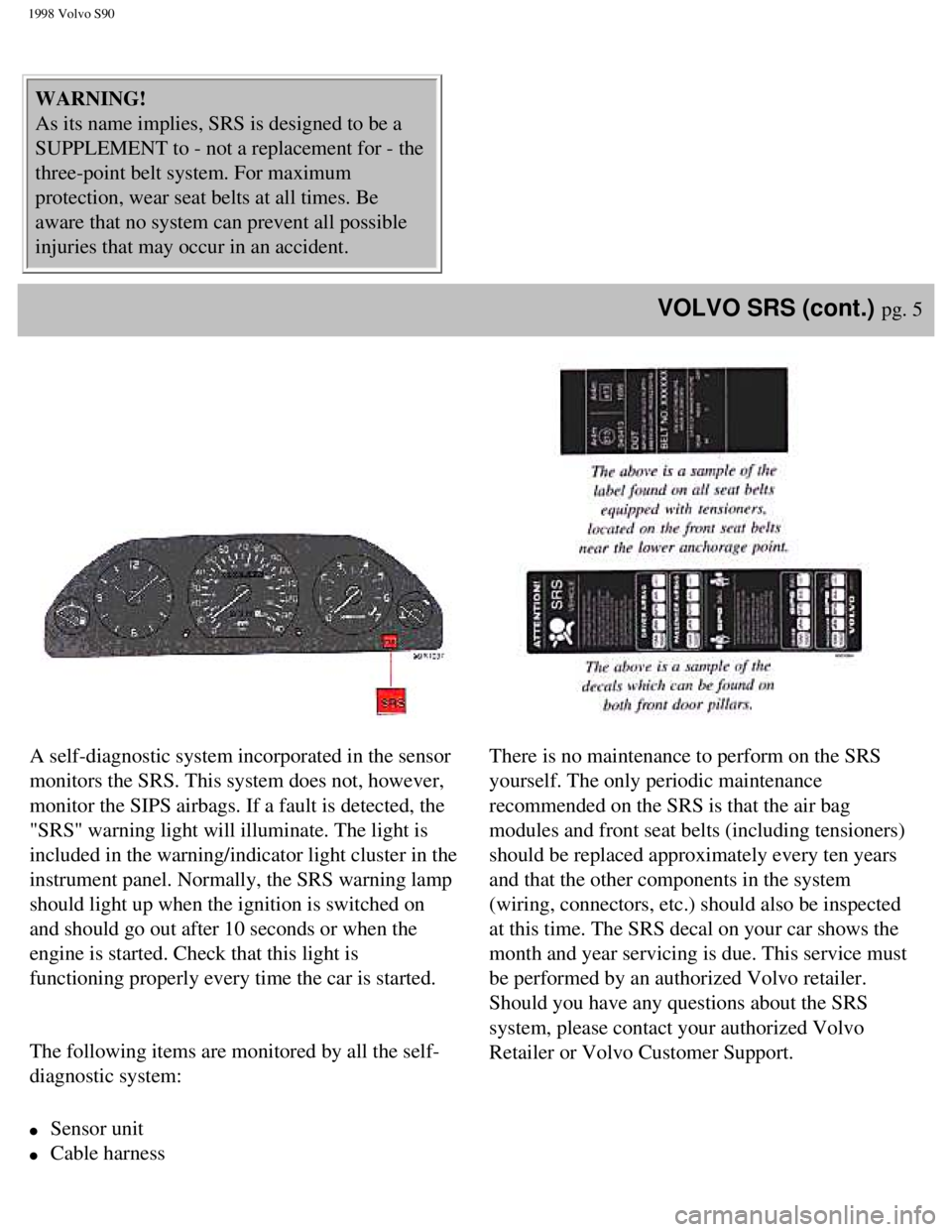
1998 Volvo S90
WARNING!
As its name implies, SRS is designed to be a
SUPPLEMENT to - not a replacement for - the
three-point belt system. For maximum
protection, wear seat belts at all times. Be
aware that no system can prevent all possible
injuries that may occur in an accident.
VOLVO SRS (cont.) pg. 5
A self-diagnostic system incorporated in the sensor
monitors the SRS. This system does not, however,
monitor the SIPS airbags. If a fault is detected, the
"SRS" warning light will illuminate. The light is
included in the warning/indicator light cluster in the
instrument panel. Normally, the SRS warning lamp
should light up when the ignition is switched on
and should go out after 10 seconds or when the
engine is started. Check that this light is
functioning properly every time the car is started.
The following items are monitored by all the self-
diagnostic system:
l Sensor unit
l Cable harness
There is no maintenance to perform on the SRS
yourself. The only periodic maintenance
recommended on the SRS is that the air bag
modules and front seat belts (including tensioners)
should be replaced approximately every ten years
and that the other components in the system
(wiring, connectors, etc.) should also be inspected
at this time. The SRS decal on your car shows the
month and year servicing is due. This service must
be performed by an authorized Volvo retailer.
Should you have any questions about the SRS
system, please contact your authorized Volvo
Retailer or Volvo Customer Support.
file:///K|/ownersdocs/1998/1998_SV90/98S90_004.htm (2 of 7)12/30/2006 \
1:52:34 PM
Page 12 of 175
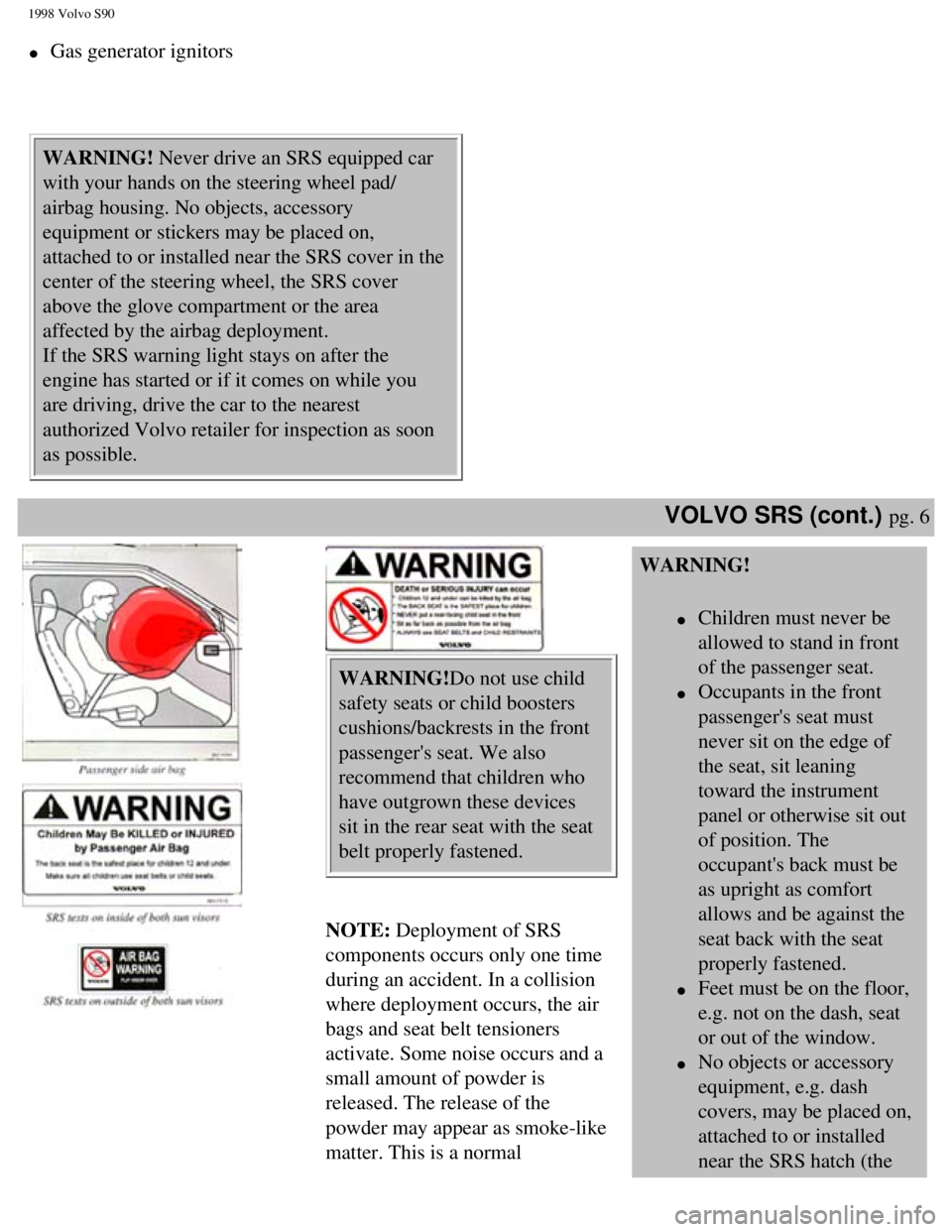
1998 Volvo S90
l Gas generator ignitors
WARNING! Never drive an SRS equipped car
with your hands on the steering wheel pad/
airbag housing. No objects, accessory
equipment or stickers may be placed on,
attached to or installed near the SRS cover in the
center of the steering wheel, the SRS cover
above the glove compartment or the area
affected by the airbag deployment.
If the SRS warning light stays on after the
engine has started or if it comes on while you
are driving, drive the car to the nearest
authorized Volvo retailer for inspection as soon
as possible.
VOLVO SRS (cont.) pg. 6
WARNING!Do not use child
safety seats or child boosters
cushions/backrests in the front
passenger's seat. We also
recommend that children who
have outgrown these devices
sit in the rear seat with the seat
belt properly fastened.
NOTE: Deployment of SRS
components occurs only one time
during an accident. In a collision
where deployment occurs, the air
bags and seat belt tensioners
activate. Some noise occurs and a
small amount of powder is
released. The release of the
powder may appear as smoke-like
matter. This is a normal
WARNING!
l Children must never be
allowed to stand in front
of the passenger seat.
l Occupants in the front
passenger's seat must
never sit on the edge of
the seat, sit leaning
toward the instrument
panel or otherwise sit out
of position. The
occupant's back must be
as upright as comfort
allows and be against the
seat back with the seat
properly fastened.
l Feet must be on the floor,
e.g. not on the dash, seat
or out of the window.
l No objects or accessory
equipment, e.g. dash
covers, may be placed on,
attached to or installed
near the SRS hatch (the
file:///K|/ownersdocs/1998/1998_SV90/98S90_004.htm (3 of 7)12/30/2006 \
1:52:34 PM
Page 22 of 175
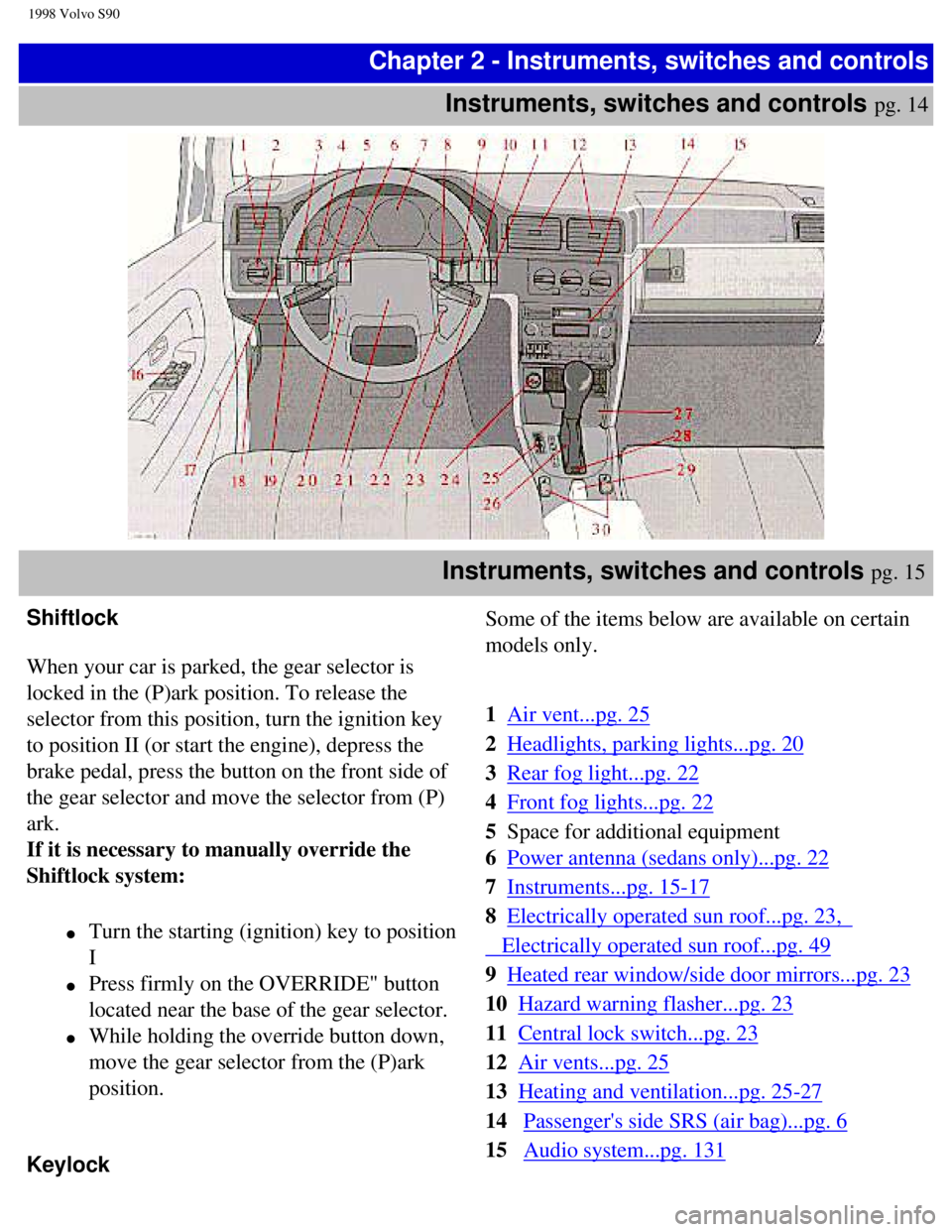
1998 Volvo S90
Chapter 2 - Instruments, switches and controlsInstruments, switches and controls
pg. 14
Instruments, switches and controls pg. 15
Shiftlock
When your car is parked, the gear selector is
locked in the (P)ark position. To release the
selector from this position, turn the ignition key
to position II (or start the engine), depress the
brake pedal, press the button on the front side of
the gear selector and move the selector from (P)
ark.
If it is necessary to manually override the
Shiftlock system:
l Turn the starting (ignition) key to position
I
l Press firmly on the OVERRIDE" button
located near the base of the gear selector.
l While holding the override button down,
move the gear selector from the (P)ark
position.
Keylock
Some of the items below are available on certain
models only.
1
Air vent...pg. 25
2
Headlights, parking lights...pg. 20
3
Rear fog light...pg. 22
4
Front fog lights...pg. 22
5 Space for additional equipment
6
Power antenna (sedans only)...pg. 22
7
Instruments...pg. 15-17
8
Electrically operated sun roof...pg. 23,
Electrically operated sun roof...pg. 49
9
Heated rear window/side door mirrors...pg. 23
10
Hazard warning flasher...pg. 23
11
Central lock switch...pg. 23
12
Air vents...pg. 25
13
Heating and ventilation...pg. 25-27
14
Passenger's side SRS (air bag)...pg. 6
15
Audio system...pg. 131
file:///K|/ownersdocs/1998/1998_SV90/98S90_014.htm (1 of 3)12/30/2006 \
1:52:36 PM
Page 24 of 175
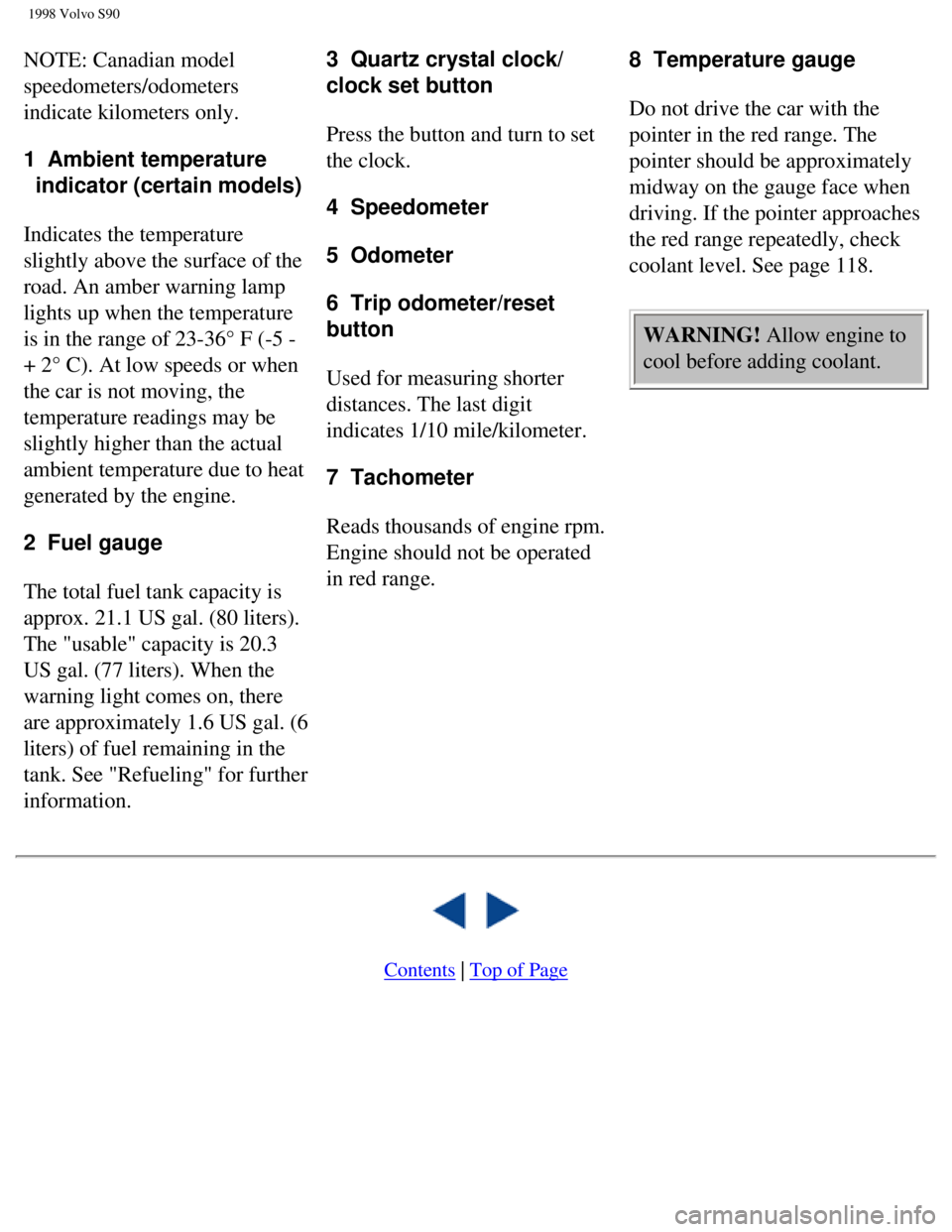
1998 Volvo S90
NOTE: Canadian model
speedometers/odometers
indicate kilometers only.
1 Ambient temperature
indicator (certain models)
Indicates the temperature
slightly above the surface of the
road. An amber warning lamp
lights up when the temperature
is in the range of 23-36° F (-5 -
+ 2° C). At low speeds or when
the car is not moving, the
temperature readings may be
slightly higher than the actual
ambient temperature due to heat
generated by the engine.
2 Fuel gauge
The total fuel tank capacity is
approx. 21.1 US gal. (80 liters).
The "usable" capacity is 20.3
US gal. (77 liters). When the
warning light comes on, there
are approximately 1.6 US gal. (6
liters) of fuel remaining in the
tank. See "Refueling" for further
information.3 Quartz crystal clock/
clock set button
Press the button and turn to set
the clock.
4 Speedometer
5 Odometer
6 Trip odometer/reset
button
Used for measuring shorter
distances. The last digit
indicates 1/10 mile/kilometer.
7 Tachometer
Reads thousands of engine rpm.
Engine should not be operated
in red range.
8 Temperature gauge
Do not drive the car with the
pointer in the red range. The
pointer should be approximately
midway on the gauge face when
driving. If the pointer approaches
the red range repeatedly, check
coolant level. See page 118.
WARNING! Allow engine to
cool before adding coolant.
Contents | Top of Page
file:///K|/ownersdocs/1998/1998_SV90/98S90_014.htm (3 of 3)12/30/2006 \
1:52:36 PM
Page 25 of 175
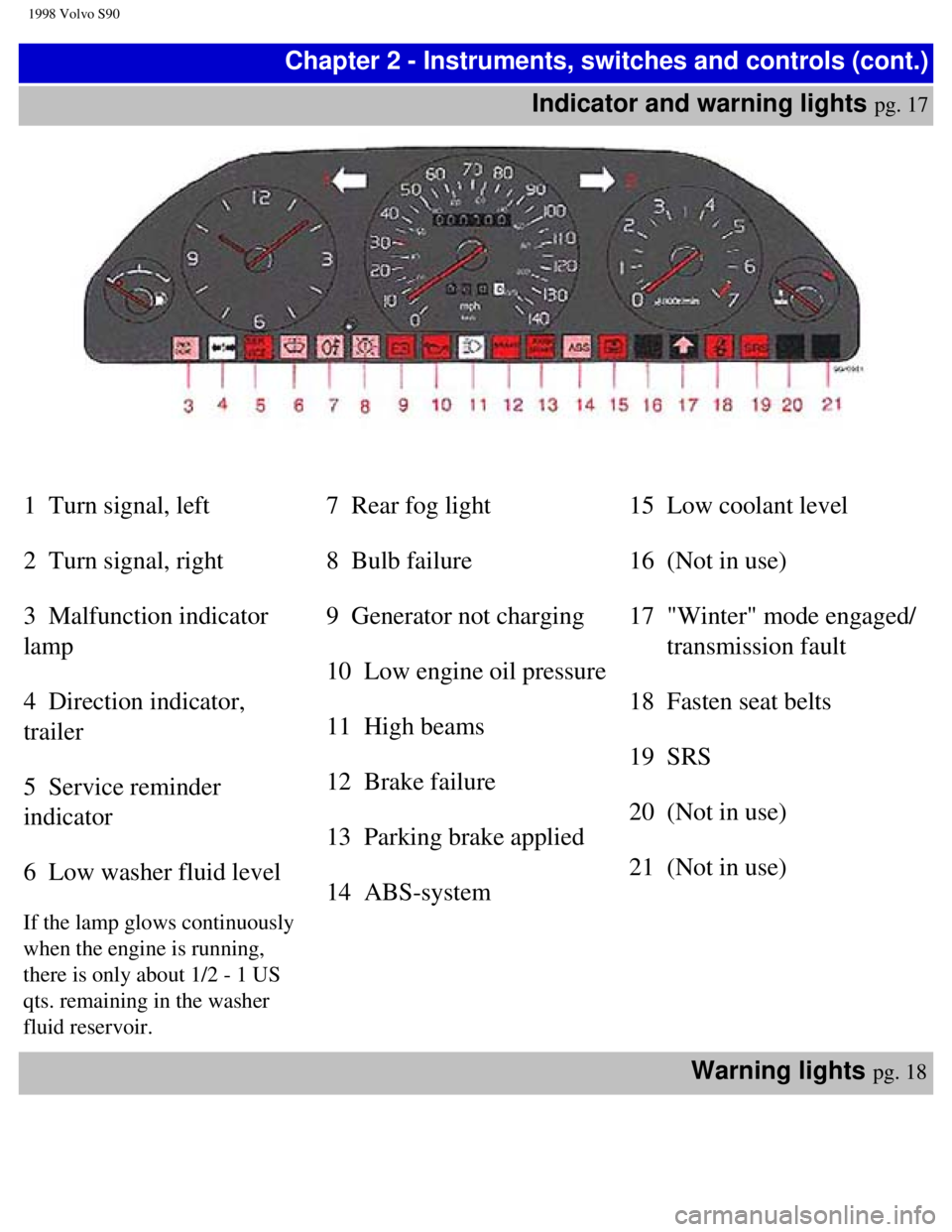
1998 Volvo S90
Chapter 2 - Instruments, switches and controls (cont.)Indicator and warning lights
pg. 17
1 Turn signal, left
2 Turn signal, right
3 Malfunction indicator
lamp
4 Direction indicator,
trailer
5 Service reminder
indicator
6 Low washer fluid level
If the lamp glows continuously
when the engine is running,
there is only about 1/2 - 1 US
qts. remaining in the washer
fluid reservoir.
7 Rear fog light
8 Bulb failure
9 Generator not charging
10 Low engine oil pressure
11 High beams
12 Brake failure
13 Parking brake applied
14 ABS-system
15 Low coolant level
16 (Not in use)
17 "Winter" mode engaged/
transmission fault
18 Fasten seat belts
19 SRS
20 (Not in use)
21 (Not in use)
Warning lights
pg. 18
file:///K|/ownersdocs/1998/1998_SV90/98S90_017.htm (1 of 7)12/30/2006 \
1:52:36 PM
Page 26 of 175
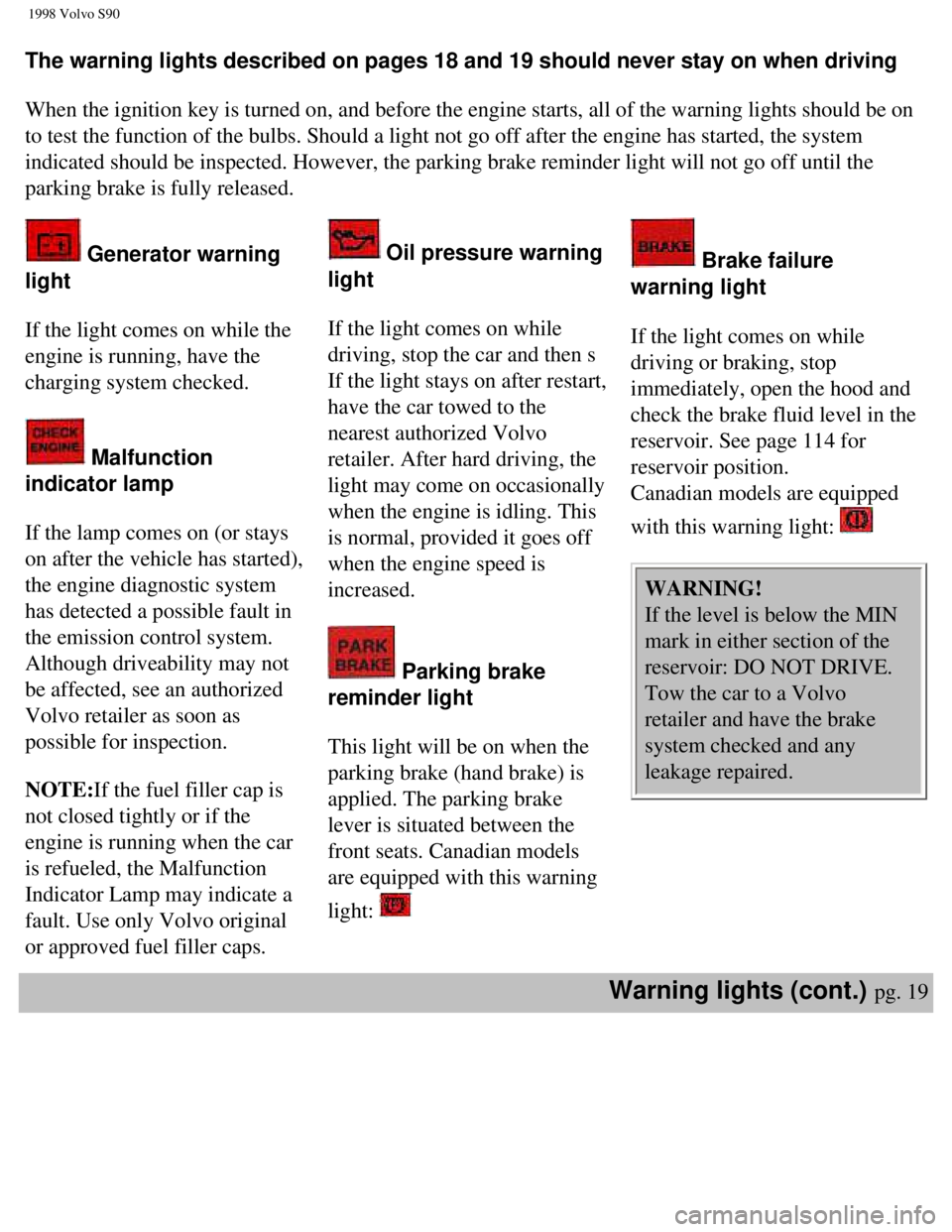
1998 Volvo S90
The warning lights described on pages 18 and 19 should never stay on whe\
n driving
When the ignition key is turned on, and before the engine starts, all of\
the warning lights should be on
to test the function of the bulbs. Should a light not go off after the e\
ngine has started, the system
indicated should be inspected. However, the parking brake reminder light\
will not go off until the
parking brake is fully released.
Generator warning
light
If the light comes on while the
engine is running, have the
charging system checked.
Malfunction
indicator lamp
If the lamp comes on (or stays
on after the vehicle has started),
the engine diagnostic system
has detected a possible fault in
the emission control system.
Although driveability may not
be affected, see an authorized
Volvo retailer as soon as
possible for inspection.
NOTE:If the fuel filler cap is
not closed tightly or if the
engine is running when the car
is refueled, the Malfunction
Indicator Lamp may indicate a
fault. Use only Volvo original
or approved fuel filler caps.
Oil pressure warning
light
If the light comes on while
driving, stop the car and then s
If the light stays on after restart,
have the car towed to the
nearest authorized Volvo
retailer. After hard driving, the
light may come on occasionally
when the engine is idling. This
is normal, provided it goes off
when the engine speed is
increased.
Parking brake
reminder light
This light will be on when the
parking brake (hand brake) is
applied. The parking brake
lever is situated between the
front seats. Canadian models
are equipped with this warning
light:
Brake failure
warning light
If the light comes on while
driving or braking, stop
immediately, open the hood and
check the brake fluid level in the
reservoir. See page 114 for
reservoir position.
Canadian models are equipped
with this warning light:
WARNING!
If the level is below the MIN
mark in either section of the
reservoir: DO NOT DRIVE.
Tow the car to a Volvo
retailer and have the brake
system checked and any
leakage repaired.
Warning lights (cont.) pg. 19
file:///K|/ownersdocs/1998/1998_SV90/98S90_017.htm (2 of 7)12/30/2006 \
1:52:36 PM
Page 29 of 175
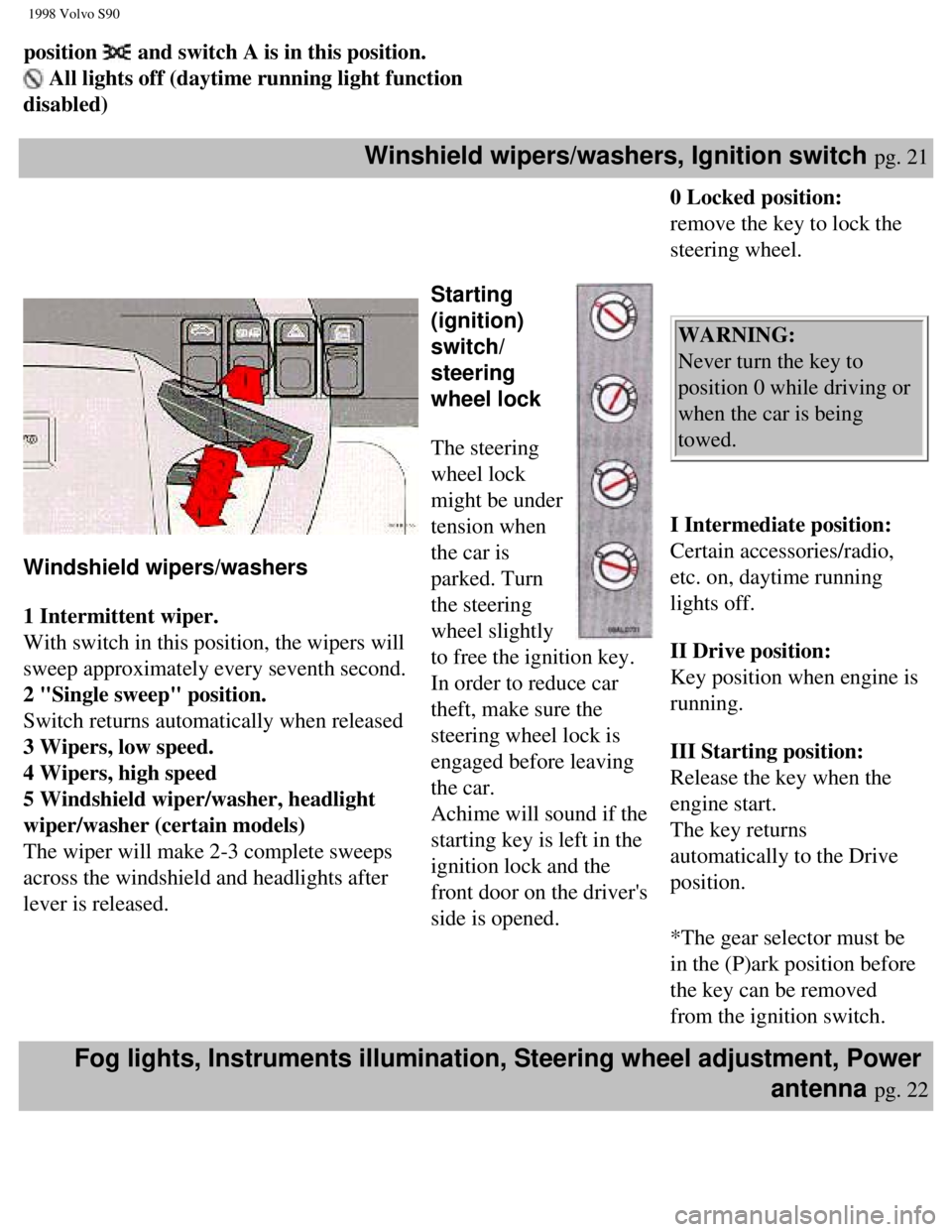
1998 Volvo S90
position and switch A is in this position.
All lights off (daytime running light function
disabled)
Winshield wipers/washers, Ignition switch pg. 21
Windshield wipers/washers
1 Intermittent wiper.
With switch in this position, the wipers will
sweep approximately every seventh second.
2 "Single sweep" position.
Switch returns automatically when released
3 Wipers, low speed.
4 Wipers, high speed
5 Windshield wiper/washer, headlight
wiper/washer (certain models)
The wiper will make 2-3 complete sweeps
across the windshield and headlights after
lever is released.
Starting
(ignition)
switch/
steering
wheel lock
The steering
wheel lock
might be under
tension when
the car is
parked. Turn
the steering
wheel slightly
to free the ignition key.
In order to reduce car
theft, make sure the
steering wheel lock is
engaged before leaving
the car.
Achime will sound if the
starting key is left in the
ignition lock and the
front door on the driver's
side is opened. 0 Locked position:
remove the key to lock the
steering wheel.
WARNING:
Never turn the key to
position 0 while driving or
when the car is being
towed.
I Intermediate position:
Certain accessories/radio,
etc. on, daytime running
lights off.
II Drive position:
Key position when engine is
running.
III Starting position:
Release the key when the
engine start.
The key returns
automatically to the Drive
position.
*The gear selector must be
in the (P)ark position before
the key can be removed
from the ignition switch.
Fog lights, Instruments illumination, Steering wheel adjustment, Power antenna
pg. 22
file:///K|/ownersdocs/1998/1998_SV90/98S90_017.htm (5 of 7)12/30/2006 \
1:52:36 PM
Page 58 of 175
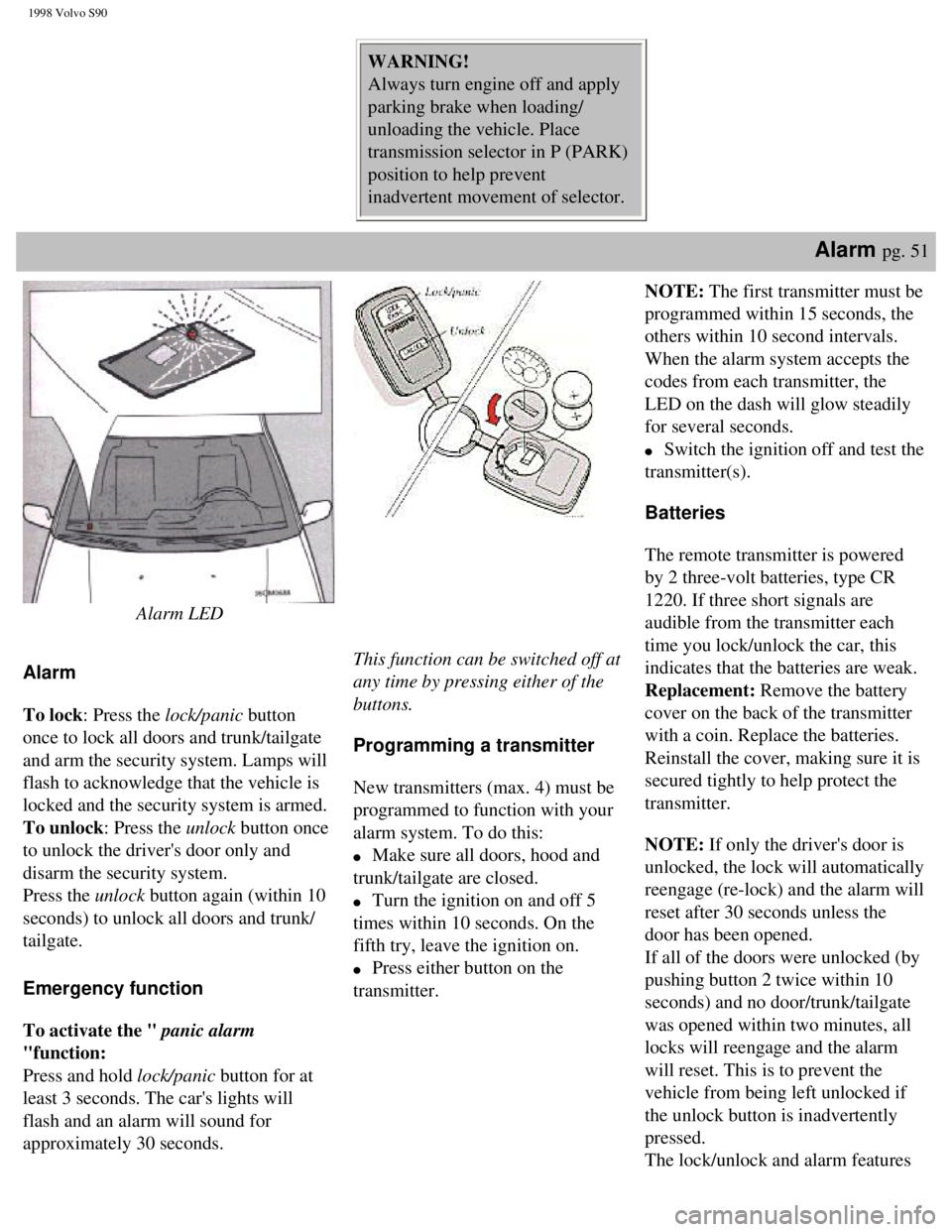
1998 Volvo S90
WARNING!
Always turn engine off and apply
parking brake when loading/
unloading the vehicle. Place
transmission selector in P (PARK)
position to help prevent
inadvertent movement of selector.
Alarm pg. 51
Alarm LED
Alarm
To lock: Press the lock/panic button
once to lock all doors and trunk/tailgate
and arm the security system. Lamps will
flash to acknowledge that the vehicle is
locked and the security system is armed.
To unlock: Press the unlock button once
to unlock the driver's door only and
disarm the security system.
Press the unlock button again (within 10
seconds) to unlock all doors and trunk/
tailgate.
Emergency function
To activate the " panic alarm
"function:
Press and hold lock/panic button for at
least 3 seconds. The car's lights will
flash and an alarm will sound for
approximately 30 seconds.
This function can be switched off at
any time by pressing either of the
buttons.
Programming a transmitter
New transmitters (max. 4) must be
programmed to function with your
alarm system. To do this:
l Make sure all doors, hood and
trunk/tailgate are closed.
l Turn the ignition on and off 5
times within 10 seconds. On the
fifth try, leave the ignition on.
l Press either button on the
transmitter. NOTE: The first transmitter must be
programmed within 15 seconds, the
others within 10 second intervals.
When the alarm system accepts the
codes from each transmitter, the
LED on the dash will glow steadily
for several seconds.
l Switch the ignition off and test the
transmitter(s).
Batteries
The remote transmitter is powered
by 2 three-volt batteries, type CR
1220. If three short signals are
audible from the transmitter each
time you lock/unlock the car, this
indicates that the batteries are weak.
Replacement: Remove the battery
cover on the back of the transmitter
with a coin. Replace the batteries.
Reinstall the cover, making sure it is
secured tightly to help protect the
transmitter.
NOTE: If only the driver's door is
unlocked, the lock will automatically
reengage (re-lock) and the alarm will
reset after 30 seconds unless the
door has been opened.
If all of the doors were unlocked (by
pushing button 2 twice within 10
seconds) and no door/trunk/tailgate
was opened within two minutes, all
locks will reengage and the alarm
will reset. This is to prevent the
vehicle from being left unlocked if
the unlock button is inadvertently
pressed.
The lock/unlock and alarm features
file:///K|/ownersdocs/1998/1998_SV90/98S90_048.htm (3 of 4)12/30/2006 \
1:52:40 PM